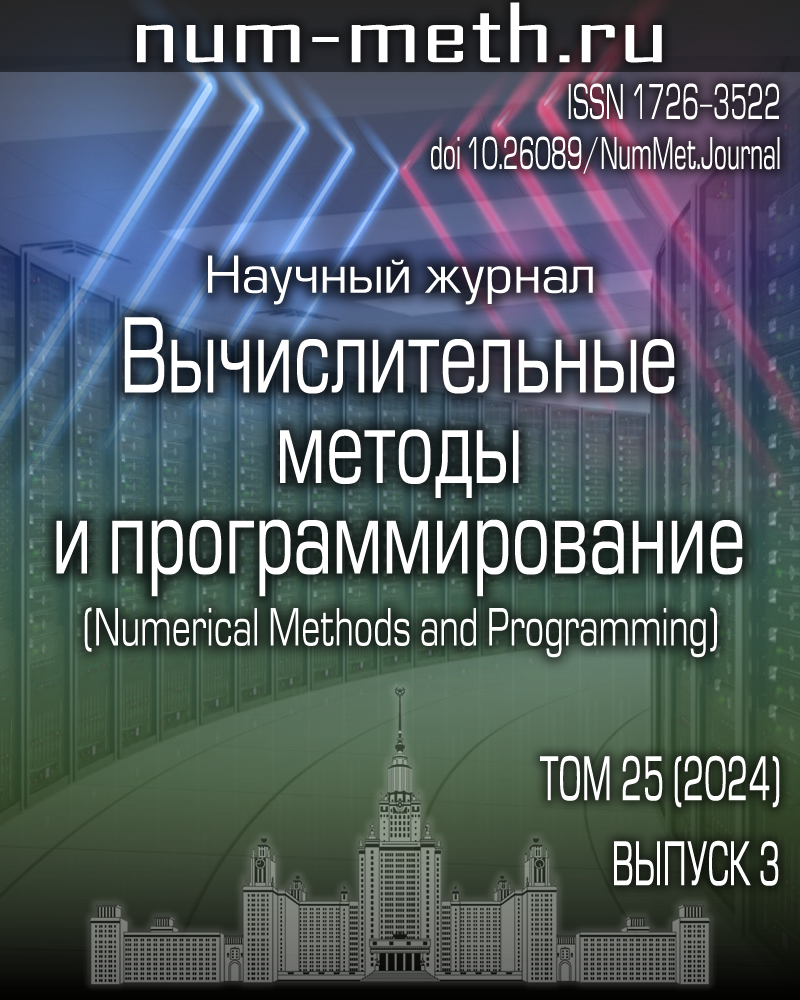DOI: https://doi.org/10.26089/NumMet.v25r323
Метод переменных направлений для построения малорангового поэлементного приближения тензоров в каноническом формате
Ключевые слова:
Аннотация
Приближение тензоров в малопараметрическом формате — важная составляющая при решении многих задач математического моделирования и анализа данных. Одним из наиболее популярных форматов представлений тензоров является каноническое тензорное разложение. На сегодняшний день большинство алгоритмов осуществляет приближение тензоров в норме Фробениуса, в то время как для некоторых приложений могут быть полезны поэлементные приближения. В данной статье предлагается метод переменных направлений для получения малорангового приближения тензоров в каноническом формате в чебышевской норме. В результате экспериментального исследования в статье демонстрируется эффективность предложенной процедуры.
Опубликован
Выпуск
Раздел
Библиографические ссылки
- B. N. Khoromskij and C. Schwab, “Tensor-Structured Galerkin Approximation of Parametric and Stochastic Elliptic PDEs,” SIAM J. Sci. Comput. 33 (1), 364-385 (2011).
doi 10.1137/100785715 - J. D. Eshelby, “Energy Relations and the Energy-Momentum Tensor in Continuum Mechanics,” in Fundamental Contributions to the Continuum Theory of Evolving Phase Interfaces in Solids (Springer, Berlin, 1999), pp. 82-119.
- S. A. Matveev, D. A. Zheltkov, E. E. Tyrtyshnikov, and A. P. Smirnov, “Tensor Train Versus Monte Carlo for the Multicomponent Smoluchowski Coagulation Equation,” J. Comput. Phys. 316, 164-179 (2016).
doi 10.1016/j.jcp.2016.04.025 - H. Lu, K. N. Plataniotis, and A. N. Venetsanopoulos, “A Survey of Multilinear Subspace Learning for Tensor Data,” Pattern Recognit. 44 (7), 1540-1551 (2011).
doi 10.1016/j.patcog.2011.01.004 - F. L. Hitchcock, “Multiple Invariants and Generalized Rank of a P-Way Matrix or Tensor,” J. Math. Phys. 7 (1-4), 39-79 (1928).
doi 10.1002/sapm19287139 - R. A. Harshman, Foundations of the PARAFAC Procedure: Models and Conditions for an “Explanatory” Multimodal Factor Analysis (UCLA Working Papers in Phonetics, Ann Arbor, 1970), Vol. 16.
- L. R. Tucker, “Some Mathematical Notes on Three-Mode Factor Analysis,” Psychometrika 31 (3), 279-311 (1966).
doi 10.1007/BF02289464 - L. De Lathauwer, B. De Moor, and J. Vandewalle, “A Multilinear Singular Value Decomposition,” SIAM J. Matrix Anal. Appl. 21 (4), 1253-1278 (2000).
doi 10.1137/S0895479896305696 - I. V. Oseledets, “Tensor-Train Decomposition,” SIAM J. Sci. Comput. 33 (5) 2295-2317 (2011).
doi 10.1137/090752286 - T. Shi and A. Townsend, “On the Compressibility of Tensors,” SIAM J. Matrix Anal. Appl. 42 (1), 275-298 (2021).
doi 10.1137/20M1316639 - V. Strassen, “Gaussian Elimination Is Not Optimal,” Numerische Mathematik 13 (4), 354-356 (1969).
doi 10.1007/BF02165411 - A. Cichocki, D. Mandic, L. De Lathauwer, et al., “Tensor Decompositions for Signal Processing Applications: from Two-Way to Multiway Component Analysis,” IEEE Signal Process. Mag. 32 (2), 145-163 (2015).
doi 10.1109/MSP.2013.2297439 - V. Lebedev, Y. Ganin, M. Rakhuba, et al., “Speeding-up Convolutional Neural Networks Using Fine-tuned CP-Decomposition,”
https://arxiv.org/pdf/1412.6553 . Cited August 29, 2024. - J. Haastad, “Tensor Rank Is NP-Complete,” J. Algo. 11 (4), 644-654 (1990).
doi 10.1016/0196-6774(90)90014-6 - M. J. Mohlenkamp, “Musings on Multilinear Fitting,” Linear Algebra Its Appl. 438 (2), 834-852 (2013).
doi 10.1016/j.laa.2011.04.019 - M. Udell and A. Townsend, “Why Are Big Data Matrices Approximately Low Rank?’’ SIAM J. Math. Data Sci. 1 (1), 144-160 (2019).
doi 10.1137/18M1183480 - S. Budzinskiy, “Entrywise Tensor-Train Approximation of Large Tensors Via Random Embeddings,”
https://arxiv.org/pdf/2403.11768 . Cited August 29, 2024. - N. Gillis and Y. Shitov, “Low-Rank Matrix Approximation in the Infinity Norm,” Linear Algebra Its Appl. 581, 367-382 (2019).
doi 10.1016/j.laa.2019.07.017 - V. Daugavet, “Uniform Approximation of a Function of Two Variables, Tabulated as the Product of Functions of a Single Variable,” Zh. Vychisl. Mat. Mat. Fiz. 11 (2), 289-303 (1971) [USSR Comput. Math. Math. Phys. 11 (2), 1-16 (1971)].
doi 10.1016/0041-5553(71)90160-1 - N. Zamarashkin, S. Morozov, and E. Tyrtyshnikov, “On the Best Approximation Algorithm by Low-Rank Matrices in Chebyshev’s Norm,” Zh. Vychisl. Mat. Mat. Fiz. 62 (5), 723-741 (2022) [USSR Comput. Math. Math. Phys. 62 (5), 701-718 (2022)].
doi 10.1134/S0965542522050141 - S. Morozov, M. Smirnov, and N. Zamarashkin, “On the Optimal Rank-1 Approximation of Matrices in the Chebyshev Norm,” Linear Algebra Its Appl. 679, 4-29 (2023).
doi 10.1016/j.laa.2023.09.007 - S. Budzinskiy, “Quasioptimal Alternating Projections and Their Use in Low-Rank Approximation of Matrices and Tensors,”
https://arxiv.org/pdf/2308.16097 . Cited August 29, 2024. - S. Budzinskiy, “On the Distance to Low-Rank Matrices in the Maximum Norm,” Linear Algebra Its Appl. 688, 44-58 (2024).
doi 10.1016/j.laa.2024.02.012
Лицензия
Copyright (c) 2024 С. В. Морозов

Это произведение доступно по лицензии Creative Commons «Attribution» («Атрибуция») 4.0 Всемирная.


